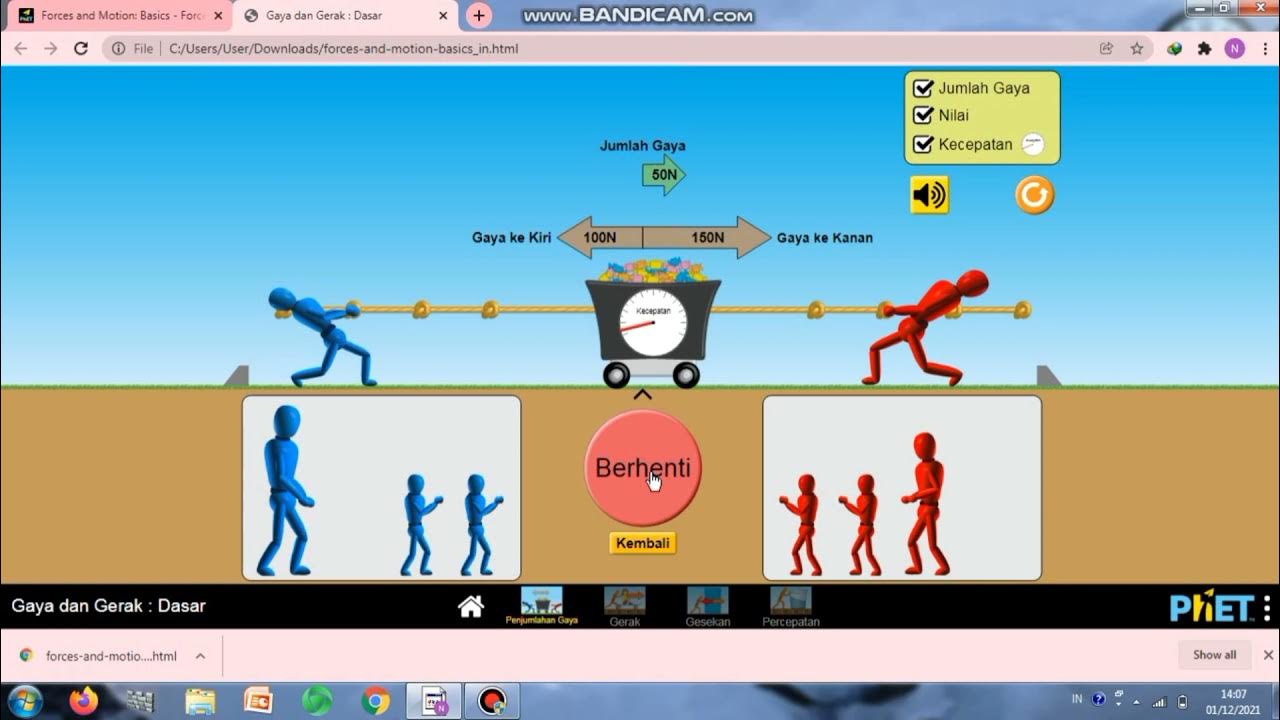Balanced and Unbalanced Forces Science 8 Quarter 1 Week 1
Summary
TLDRThis video script explores the concepts of balanced and unbalanced forces, explaining how they affect an object's state of motion. It clarifies that balanced forces, being equal and opposite, result in a net force of zero, keeping objects at rest or in constant velocity. Conversely, unbalanced forces lead to changes in motion, causing objects to accelerate, change speed, or direction. The script uses examples like a book on a table and a hanging pen to illustrate these principles, emphasizing the relationship between forces and motion.
Takeaways
- 📚 Force is defined as a push or pull and is commonly measured in Newtons, honoring Sir Isaac Newton.
- 📐 Force is a vector quantity, having both magnitude and direction, represented by arrows in diagrams.
- 🌐 Balanced forces are equal in magnitude and opposite in direction, resulting in a net force of zero.
- 📚 When forces are balanced, an object at rest stays at rest, and a moving object continues to move at a constant velocity.
- 📉 The net force on an object at rest is zero when balanced forces are acting upon it, meaning there is no motion.
- 📈 Unbalanced forces occur when forces do not cancel each other out, leading to a non-zero net force.
- 💨 Unbalanced forces change an object's state of motion by causing it to accelerate, either in speed or direction, or both.
- 📍 An object in motion with balanced forces maintains a constant velocity, moving in a straight path at a steady speed.
- 🔄 When an object is acted upon by unbalanced forces, it may slow down, speed up, or change direction.
- 📌 The state of motion of a stationary object remains unchanged under balanced forces, but it moves when acted upon by unbalanced forces.
- 🔍 In summary, balanced forces maintain an object's current state of motion, while unbalanced forces induce changes in motion.
Q & A
What is the definition of force?
-Force is defined as a push or a pull and is commonly expressed in Newton, in honor of Sir Isaac Newton. It is a vector quantity, meaning it has both magnitude and direction.
What is the significance of the term 'balanced forces'?
-Balanced forces are forces that are equal in magnitude and opposite in direction, resulting in a net force of zero. They cancel each other out, causing an object to remain at rest or continue moving at a constant velocity.
What is the net force when forces are balanced?
-The net force when forces are balanced is equal to zero because the forces cancel each other out.
Why does a book resting on a tabletop not move?
-The book does not move because the downward gravitational force exerted by the Earth is balanced by the upward normal force exerted by the table, resulting in no net force.
What happens to an object's state of motion when it is subjected to balanced forces?
-When an object is subjected to balanced forces, its state of motion does not change. If the object was at rest, it stays at rest, and if it was moving, it continues to move at a constant velocity.
What is the term for the force exerted by a string when hanging an object?
-The force exerted by a string when hanging an object is referred to as the tension force.
What happens when an object is subjected to unbalanced forces?
-When an object is subjected to unbalanced forces, there is a net force acting on it, causing a change in the object's state of motion, which could be a change in speed, direction, or both.
Why does a pen fall when the string holding it is cut?
-The pen falls because the tension force that was balancing the gravitational pull is no longer present, leaving the gravitational force unopposed, causing the pen to accelerate downward.
How does a net force cause an object at rest to move?
-A net force causes an object at rest to move by unbalancing the forces acting on the object, resulting in motion in the direction of the net force.
What is the relationship between unbalanced forces and acceleration?
-Unbalanced forces cause acceleration, which means a change in the speed or direction of an object's motion. When an object is accelerating, it indicates that there is a net force or unbalanced force acting on it.
How can you determine if the forces acting on a moving object are balanced?
-If a moving object maintains a constant velocity, meaning it moves at a constant speed in a straight path, then the forces acting on it are balanced.
Outlines

Dieser Bereich ist nur für Premium-Benutzer verfügbar. Bitte führen Sie ein Upgrade durch, um auf diesen Abschnitt zuzugreifen.
Upgrade durchführenMindmap

Dieser Bereich ist nur für Premium-Benutzer verfügbar. Bitte führen Sie ein Upgrade durch, um auf diesen Abschnitt zuzugreifen.
Upgrade durchführenKeywords

Dieser Bereich ist nur für Premium-Benutzer verfügbar. Bitte führen Sie ein Upgrade durch, um auf diesen Abschnitt zuzugreifen.
Upgrade durchführenHighlights

Dieser Bereich ist nur für Premium-Benutzer verfügbar. Bitte führen Sie ein Upgrade durch, um auf diesen Abschnitt zuzugreifen.
Upgrade durchführenTranscripts

Dieser Bereich ist nur für Premium-Benutzer verfügbar. Bitte führen Sie ein Upgrade durch, um auf diesen Abschnitt zuzugreifen.
Upgrade durchführenWeitere ähnliche Videos ansehen

Newton's first law of dynamics and inertia of bodies, that is why we fasten our seat belts !?

Two Dimensional Motion (1 of 4) An Explanation

Balanced & Unbalanced Forces | Forces & Motion | Physics | FuseSchool

Forces and Dynamics - free body diagrams - (IB Physics, AP, GCSE, A level)

Simulasi Phet Hukum Newton | Media Pembelajaran Fisika

Balanced and Unbalanced Forces
5.0 / 5 (0 votes)
